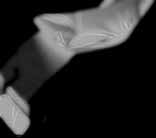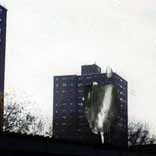|
|
||||
| Considerations, images,
projects by Gianluca Milesi |
||||
| [in italiano] | Born in 1962, Gianluca Milesi lives and works in New York and Milan. He works with a multi-disciplinary approach to architecture and design and he is involved in experimentation with computer technology. He collaborated with different offices in Europe and United States as well as Vittoriano Vigano' in Milan and Peter Eisenman in New York and on shop renovations in Paris. He developed real architectonic projects for buildings, parks, interiors and works of research and experimentation and has participated in different international competitions with mentions and publications. He taught at the Polytechnic of Milan. His work has been exhibited in Italy and Europe. His research is collected under the title Science-architecture. |
[26may2000] | ||
 Some considerations |
||||
   Studies on membranes, surfaces and space. |
In the United States the 10% of the sales is through internet, this
article is written for an internet site and I normally contact people via e-mail, I do
collaborations with very far friends without traveling, all my job could be recorded on 3
or 4 cds. If I was saying these things five years ago probably nobody could understand.
It's evident that something is going on. It's notorious that we are in the information
age. Technology advances at a not controlled speed. Nanotechnologies, molecular
technologies, robotics, nanorobotics, self-replication, genetic engineering, engineered
organism- concepts not easy to understand in their real meaning- seem to bring big and
maybe dramatic transformations in our life; in 30 years we will have ; according to
accredited studies, 1000000 times faster computers. The "Society of Control" -definition by William Burroughs- is taking the place of the society of the production: this means that the processes of production become more non-material or are moved away and instead their control is established; as an example I could bring the answer machines with dozens of options and no more operators, the credit cards, the numeric controlled machine, and many others. The "New Economy" that is just a commerce through e-mail and credit card, seems to be the future of the economy. The physical spaces are shrinking and maybe become empty, the production is concentrated or pushed to low work cost country, the cities become information's agglomerates, the earth surface a fluid net of connections. The Global Village... Marshall McLuhan, the robotics of the last generation, the virtual... In short a big transformation is going on whose effects are evident and sometimes generates dramatic and improbable previews of the future world and a big amount of rhetoric. |
|||
 A first consideration on architecture and an analysis attempt |
||||
 Proposal for the tickets booths in Times Square New York. |
The contemporary architecture and the more 'experimental' in particular,
linked to the technologies of information is without any doubt the result of this general
contemporary condition. In comparison to the 'modern' architecture it becomes more
non-material, easy to transfer to long distance, uses technologies studied by the
microprocessors architects and engineers and the computer programmers -nothing bad in
this, every form of art or architecture needs a specific technology-, express itself
through forms generated by applications of complex geometry which seem to fit better the
formalization of a displacement sensibility -as a space and time contamination out of a
consequential order- uses transparencies, movement, takes vantage from the design process
accidents. It's no more depending from the 'function', at least from the spatial function, it's more free, less moral, or moralist -not a-moral but maybe an expression of a changing moral- it doesn't rise from a building technology, maybe it creates the premonitory signs of it. This kind of architecture that could be called information architecture, transarchitecture, virtual architecture, or in another way, brought and brings to a solution of continuity with the tradition and the precedent way to approach a project and brings to a more advanced level of research or simply different. It's the case to ask if what is going on will be just a short and specific moment and strictly linked to a period, as the postmodernism or the decostructivism were, o it will determine real changing with time. and a real progress. It's now easy to fall on rhetoric and banal speeches, I will simply try to express a personal feeling. |
|||
 An opinion |
||||
| My opinion is that we are really at a point of flexion, architecture
becomes richer with a formal freedom, frustrated maybe from the modern movement or better
the modernism, creates the premises for the proposition of forms and solutions not
predictable and interesting for they geometric and spatial research end the potentiality
of evolution. I'm personally convinced of the quality of this evolution, my personal
research, with limits of subjectivity and means, is directly connected to the concepts I'm
trying to explain. I think also that architecture is opening to other disciplines, visual
art, sculpture, video production, web design, trying not to close itself in a strict
professional circle; many friends artists showed themselves more interested in the last
production of architecture -buildings or projects. On the other hand I think architecture
has to make an effort in order to reach the graphic end technological level of other
disciplines as the cinematography, or computer animation. |
Proposal for a marine park in Lorient (fr); organic shaped pertly underground volumes connects the existing submarines basis and the landscape. |
|||
| Continue |
||||
 Proposal for the Housing Project in new York City; parasites are added to the existing buildings in order to transform their functional and formal organization. |
But if this could be true there is a consideration to be done on an other
aspect of the reality of the present day and this is for sure connected to the
transformations I was speaking about before -also if this connection is not immediately
understandable. It seems to me that a fracture is creating between the progress of the
architectural experimentation and what is going as a paradox in the large scale economy.
It seems to me that we are going toward a domain of the economy of the corporations
-especially in the United States- which is not giving time, space or even the sensibility
to promote the production of real experimental architecture; this kind of economy produces
often big, boring, buildings, sometimes even vulgar, designed just to satisfy the equation
space/money (with some rare exception). The consequence is that the more experimental architecture is, by choice or not, closed to elite cultivated academic circles and quite isolated from the rest of the world and the society. In New York, which could be a focal point for the research. almost nothing of really innovative was built in the last 20 years. For paradox the academic world ,historically conservative, seems now to be the only ambit open to the research (I just speak about architecture, not design, cinema or fashion). On the other hand it's important to ask if it is really important to build: personally I find more interesting the few objects designed by Eileen Gray or the drawings of Zaha Hadid or the project for the virtual Guggenheim to some architecture which is just real estate production -in the less poetic meaning. Form my window in Brooklyn I see buildings which nothing have to do with any kind of 'tectonic' but they are enormous constructions. I'm personally more interested in a high quality virtual project than in the big number of skyscrapers built in Shangay in the last few years. In conclusion I think that money often doesn't match culture -what actually happened in Bilbao. So It seems to me that the architectural experimentation is on a way with a lot of obstacles; in the other hand it's not difficult to understand the value and say that it is one of the best expression of the information paradigm. A last consideration which doesn't want to contradict what I said before but that wants to make this ideas stronger. Somebody says that architecture of brick and mortar is finished and now the only architecture is the architecture of the virtual. I don't think this is real. As well as I don't believe cybersex could be interesting as good as a real sexual relation. I personally don't believe cities will be museums as Marshall McLuhan says, or I don't think Nietsche is totally right when he says that the work of the artist will be just to organize parties and I don't find the Situationists theories applicable to the metropolis. I think reality must be changed in reality; I think that at the end will be necessary to imagine new building technologies connected with the new paradigm of the information in order to give real impact to the change; I think it's necessary to think to build a new reality faithful to the understanding of the evolution and with the chance to exalt its qualities; it's necessary to build 'new' buildings. Bernard Cache after he spoke about the evolution of the geometry through the analysis of the complex theories through the centuries, arrives at the conclusion of his essay defending the actuality of the theory of Euclide as the best way to describe the physical reality. The same thing could be said about the architecture of the information, of the displacement, of the connection-concepts probably not Euclidean. This architecture needs to be built to be called architecture, needs real buildings, something in some way Euclidean. It is my opinion that if this architecture of the information created a new paradigm, and I personally believe in that, this architecture will be part of the general paradigm of architecture. And I hope to see as soon as possible the effects of it. |
 |
||
| Images and projects My personal research is involved in investigations of space possibilities through the computer technology in a conception and representation stage. Starting from a theoretical, abstract, possibly critical approach to themes, forms, concepts and methods, a real architectural design is proposed, in terms of functions and fruition. Keywords line surface deformation repetition accident displacement mathematics volume fluidity organic unit micro/macro space movement synthesis gravity net Gianluca Milesi popomilesi@aol.com |
||||
|
||||
| laboratorio
|
||||